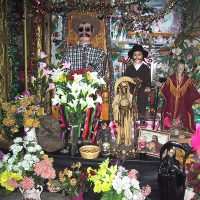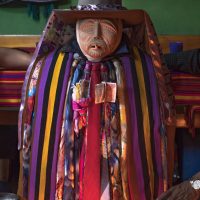Maximon : The Trickster Saint
Listen
At a glance
| Description | |
|---|---|
| Origin | Mayan Mythology |
| Classification | Spirits |
| Family Members | N/A |
| Region | Guatemala |
| Associated With | Trickster |
Maximon
Introduction
Maximón, also known as San Simón, stands as one of Guatemala’s most mysterious and paradoxical spiritual figures, a folk saint and trickster deity whose worship bridges ancient Mayan cosmology and Catholic devotion. Rooted in the highlands of Guatemala, Maximón’s cult embodies centuries of religious syncretism, evolving from pre-Columbian beliefs and transforming under the shadow of Spanish colonial rule. He is revered as a guardian, a judge, and a negotiator between worlds honored by both the righteous and the sinners. To his devotees, Maximón represents balance and contradiction: a saint who smokes cigars, drinks rum, and accepts bribes, yet blesses those who approach him with sincerity. His popularity endures not only in indigenous communities but also among urban believers and diaspora groups, illustrating how this enigmatic figure continues to adapt to modern spirituality.
Physical Traits
Depictions of Maximón vary across regions, yet all portray him as a distinctly human-like effigy exuding both authority and indulgence. In Santiago Atitlán, his image sits in a chair dressed in a fine Western-style suit, colorful scarves, and a wide-brimmed hat. A cigar or cigarette is often placed in his mouth, symbolizing his connection to worldly pleasures, while bottles of rum or moonshine lie at his feet as offerings. Some versions feature sunglasses or dual masks, one facing forward and another backward, signifying his ability to see in all directions – past, present, and future.
Crafted from sacred divination woods, such as the Tz’ajtel tree, his effigy reflects deep ritual symbolism. The staff, or vara, held in his hand denotes authority, and the layers of woven sashes around him echo his duality: protector and punisher, ancestor and outlaw. These physical traits make Maximón both accessible and divine, a reflection of a being who inhabits both the sacred and the profane.
Family
Maximón’s origins are not tied to a single mythological family but to a network of spiritual relationships within Maya cosmology and colonial reinterpretation. He is often equated with Rilaj Mam, the “Great Grandfather,” a powerful ancestral spirit representing the cyclical nature of life and death in Mayan belief. Mam signifies both grandfather and grandchild, a symbol of rebirth and continuity among generations.
In syncretic interpretations, Maximón’s identity blends with figures from Christian lore such as Saint Peter, Judas Iscariot, or even the conquistador Pedro de Alvarado. These overlapping associations reveal how indigenous communities merged new colonial narratives with their own cosmological frameworks. Rather than having a biological family, Maximón belongs to a spiritual lineage that links gods, saints, and ancestors across time, serving as the living embodiment of unity between indigenous and colonial worlds.
Other names
The name Maximón itself reflects his hybrid origins. Scholars suggest it is derived from the Mayan term Mam (meaning “ancestor” or “grandfather”) combined with Simón, a reference to Saint Simon Peter. Across Guatemala, he is known by various epithets, each expressing a different aspect of his character.
In Santiago Atitlán, he is called Rilaj Mam or “Great Grandfather,” emphasizing his ancestral wisdom. Among Spanish-speaking devotees, San Simón is more common, reflecting his Catholic veneer. In some towns, people call him El Gran Abuelo (The Great Grandfather), Don Ximon (Lord Simon), or El Tío (The Uncle), terms of both respect and intimacy. Other communities refer to him as Hermano Pedro (Brother Peter), El Viejo (The Old Man), or Trueno (Thunder), highlighting his transformative and unpredictable nature.
Each name reveals how Maximón adapts to local traditions and beliefs, changing identity while maintaining his spiritual essence—a hallmark of his enduring power in Guatemalan folklore.
Powers and Abilities
Maximón’s powers encompass nearly every aspect of life, reflecting his complex moral duality. He is invoked for prosperity, fertility, justice, love, protection, and revenge. As a trickster god, he grants favors that other saints might refuse, serving those on the fringes of society – lovers seeking fidelity, merchants chasing success, or individuals craving vengeance against wrongdoers. His role as an “opener of roads” or Lord of Crossroads makes him vital to travelers, traders, and those embarking on new ventures.
In agricultural regions, Maximón is considered a bringer of rain and fertility, linked to seasonal cycles that sustain crops and livelihoods. As the Lord of Diviners and Day-keepers, he aids shamans and spiritual guides in interpreting omens, healing illnesses, and balancing cosmic energies. Yet, his assistance is never unconditional. His followers must honor him through ritual offerings – tobacco, rum, money, and candles, given with sincerity and respect.
Failure to fulfill promises to Maximón can bring misfortune. His justice is swift and impartial, punishing deceit and arrogance while rewarding humility. This transactional nature mirrors the human world he represents: one of negotiation, exchange, and reciprocity. Above all, Maximón’s power lies in his humanity, he understands imperfection and accepts it, making him both divine and deeply relatable.
Modern Day Influence
Despite centuries of Catholic suppression and modern evangelical opposition, Maximón’s cult remains thriving across Guatemala and beyond. His effigy travels annually from house to house under the care of cofradías, or local brotherhoods, who perform daily rituals, smoke cigars in his honor, and share offerings from the faithful. During Holy Week, Maximón is paraded through towns in striking processions that blend Maya ceremony with Christian pageantry, a vivid display of cultural fusion.
Temples dedicated to him, such as the famous San Andrés Itzapa shrine, attract thousands of pilgrims each year who burn offerings of incense, flowers, and colored candles. Tourists, anthropologists, and spiritual seekers visit these shrines, fascinated by the coexistence of Christian prayers and indigenous chants.
Beyond Guatemala, Maximón’s following has expanded into Mexico, the United States, and Canada, where migrant communities have built home altars and temples to San Simón. These diasporic shrines reflect his continued relevance as a patron of resilience, protection, and cultural identity among displaced people.
In art, literature, and academic discourse, Maximón has become a symbol of syncretism and resistance—a reminder of how indigenous traditions survived colonization by transforming rather than disappearing. His image, often depicted smoking and wearing sunglasses, appears in modern murals, documentaries, and even digital media, symbolizing rebellion against hypocrisy and the persistence of native faiths.
Even in the 21st century, Maximón remains a living deity, evolving with his devotees. He represents not perfection but acceptance—the ability to find balance between morality and indulgence, faith and doubt, tradition and change. His enduring appeal lies in his humanity: flawed, wise, indulgent, and compassionate. In a world divided by dogma, Maximón continues to stand at the crossroads—guardian of the forgotten, mediator of opposites, and eternal trickster who teaches that divinity can wear many faces.
Related Images
Source
Encyclopedia.com. (2025). Maximón. Retrieved from https://www.encyclopedia.com/environment/encyclopedias-almanacs-transcripts-and-maps/maximon
National Geographic. (2018, January 24). Meet Maximón: The liquor-drinking, chain-smoking saint. Retrieved from https://www.nationalgeographic.com/travel/article/maximon-santiago-atitlan-maya-saint
Wikipedia. (2025). Maximón. Retrieved from https://en.wikipedia.org/wiki/Maximón
Amerispan. (n.d.). Maximón: Guatemala’s Evil Saint. Retrieved from http://www.amerispan.com/travel/article/Maximon__Guatemala_s_Evil_Saint/238/
LifeGate. (2020). Maximón or San Simón: The Mayan folk saint who drinks, smokes and offers protection. Retrieved from https://www.lifegate.com/maximon-maya-saint-guatemala
Occult World. (2017). Maximón. Retrieved from https://occult-world.com/maximon/
University of Miami. (2020). Maximón: The Shape-Shifting Trickster Provides Hope for the Marginalized. Retrieved from https://scholarship.miami.edu
Mythus Fandom. (2018). Maximón (Ri Laj Mam / San Simón). Retrieved from https://mythus.fandom.com/wiki/Maximón
Frequently Asked Questions
What is lorem Ipsum?
I am text block. Click edit button to change this text. Lorem ipsum dolor sit amet, consectetur adipiscing elit. Ut elit tellus, luctus nec ullamcorper mattis, pulvinar dapibus leo.
What is lorem Ipsum?
I am text block. Click edit button to change this text. Lorem ipsum dolor sit amet, consectetur adipiscing elit. Ut elit tellus, luctus nec ullamcorper mattis, pulvinar dapibus leo.
What is lorem Ipsum?
I am text block. Click edit button to change this text. Lorem ipsum dolor sit amet, consectetur adipiscing elit. Ut elit tellus, luctus nec ullamcorper mattis, pulvinar dapibus leo.
What is lorem Ipsum?
I am text block. Click edit button to change this text. Lorem ipsum dolor sit amet, consectetur adipiscing elit. Ut elit tellus, luctus nec ullamcorper mattis, pulvinar dapibus leo.
What is lorem Ipsum?
I am text block. Click edit button to change this text. Lorem ipsum dolor sit amet, consectetur adipiscing elit. Ut elit tellus, luctus nec ullamcorper mattis, pulvinar dapibus leo.








